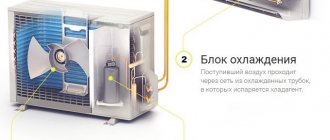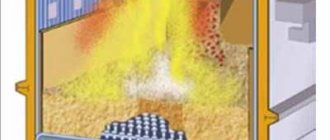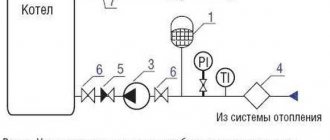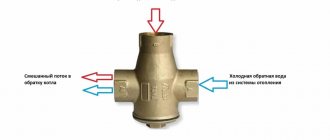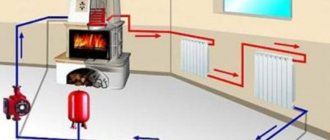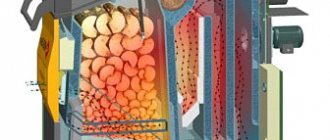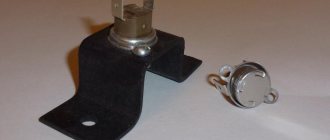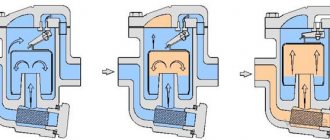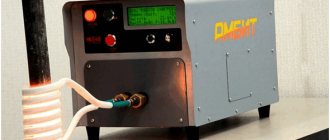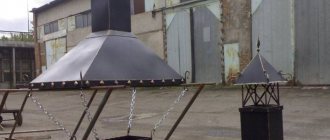Agree that a rosette is generally not the most important decoration of a room, and therefore you should not focus on it and place it in a conspicuous place. Of course, the location of the outlet for the air conditioner does not greatly affect the overall interior of the room, but it should be carefully thought out so as not to cut the wall in the future and not to use extension cords again.
We will tell you about where to install air conditioning sockets. We will show you the best and safest places to place a power point. The article also provides recommendations for masking sockets and cords from climatic technology.
Features of sockets for air conditioner
The installation of a conventional domestic air conditioner allows the use of standard power outlets. Most of the factory-fitted air conditioners have plugs and cords, but all the same, climatic equipment is not a TV or refrigerator, so you need to take care of arranging electrical lines for it in advance.
Such equipment belongs to powerful technical devices that consume a large amount of electricity during operation.
Because of this, you cannot connect other energy-intensive equipment to the same outlet with an air conditioner. Correctly performed electrical installation when connecting climatic equipment to the network is a guarantee of long-term and efficient operation of these devices.

Professional development of a design project involves the determination of the location of the outlet for HVAC equipment in the room, regardless of its purpose
Each air conditioner has its own indicator of the rated power consumption. This value must be taken into account when installing the device in order to minimize the risk of an accident and ensure the normal power supply of the equipment. It is indicated in the data sheet of the device. But when laying wiring lines and sockets, it is better to take indicators slightly higher.
Typical power ratings for a non-production air conditioner typically range from 800 to 1800 watts. The exact value depends on the type of climatic equipment and the area of the refrigerated room. In most cases, a simple wall outlet with a rated load of about 16A will suffice for such equipment.
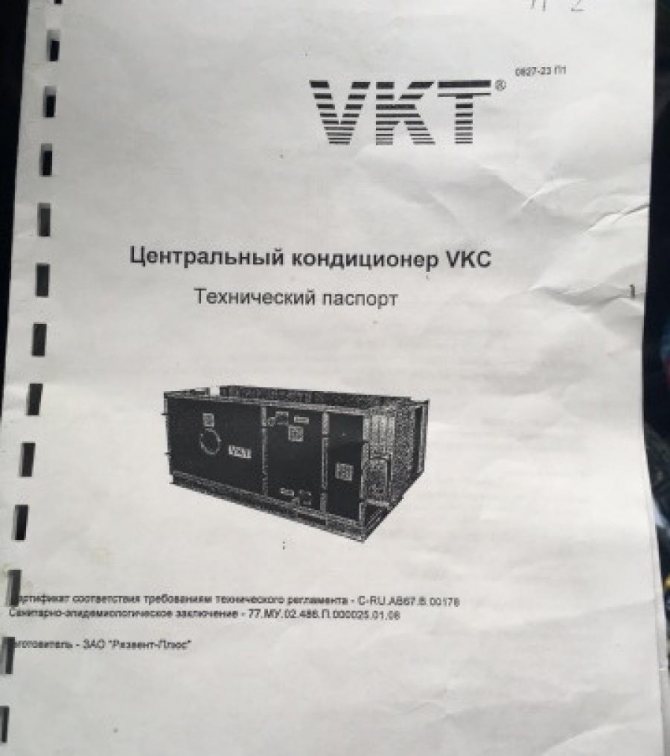

Before installing the outlet for the air conditioner, you should familiarize yourself with the main characteristics of the climatic equipment specified in the technical passport of the device.
But for split systems designed to cool huge areas, such an outlet will not work, since it will not be able to withstand the load. For powerful equipment, the sockets are selected individually, depending on the power parameters of the device.
It is best to buy euro sockets to connect climatic equipment. They perfectly cope with high loads and have a long service life. The most reliable euro sockets include products of the brands ABB, Legrand, Siemens, GIRA, etc.
The location where the electrical outlet will be located
There may be different air conditioners in the room. The socket or outlets must be installed so that the power cord can be easily reached. Accessibility is a basic requirement for an outlet.
When choosing a specific location, there are a number of details to consider:
- Air conditioner power.
- The thickness of the section of the wiring.
- Arrangement of furniture.
Interior design is also of great importance for the installation site. In pursuit of practicality, you should always remember about the aesthetic component.The socket should be installed in an accessible place, but so that the wires from the equipment are not noticeable or, at least, do not negatively affect the appearance of the room, do not spoil the walls and windows.
As a rule, the socket is mounted next to the air conditioning unit. The height of the part will depend on the size of the hardware.
Standard dimensions of air cooling units:
- Dimensions of the indoor unit (hxwxd) - 24x71 or 8x18.
- Dimensions of the outdoor unit (hxwxd) - 54x77.
Tips and tricks for choosing where to install an electrical outlet:
- 15 centimeters is the minimum distance between the ceiling and the nearest edge of the socket.
- 30 centimeters is the distance from the ceiling to the outlet.
- 25 centimeters is the recommended distance between the walls if the indoor unit of the air conditioner is placed in a corner.
- 10 centimeters is the recommended distance between the floor and the bottom edge of the outlet if it is located at the bottom of the wall.
- The point of connection to the network should not be blocked by anything.
We recommend that you familiarize yourself with: Calculating the area of air ducts and fittings
Sometimes an existing outlet is used to connect. In this case, you need to be careful and measure the length of the power cord. It should reach the point without tension.
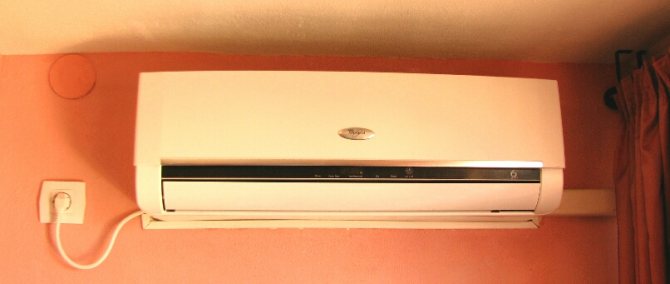

Where is the best place to install the outlet?
Air conditioning cords can be up to a meter in length, and therefore it is necessary to plan the location of the outlet in such a way as to exclude the possibility of sagging of the wires. If, when installing the air conditioner, no electrical work is planned, you will have to dodge: spoil the decoration of the room or try to use existing connectors.
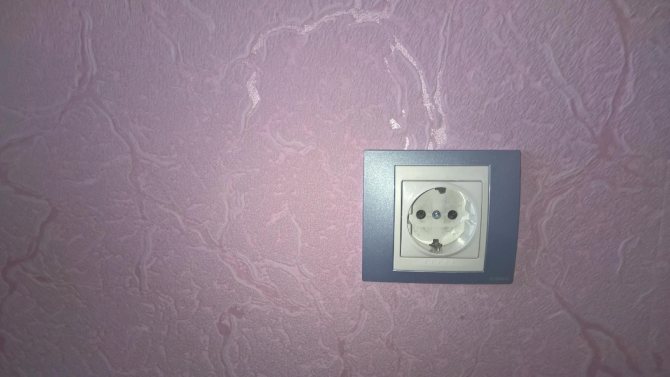

The electrical outlet for a domestic air conditioner is of standard dimensions, but its location in a residential or commercial space must be determined in advance
When installing a simple household air conditioner in an ordinary apartment, few people think about the location of the outlet for the split system. The device is connected to the nearest 220V outlet through an adapter, with a wire extension or directly (depending on the location of the outlet point of the power network).
But such a connection is only suitable for non-inverter models with a capacity of less than 4 kW. Also, if a certain phase orientation is observed, this method can be used to connect low-power inverter-type climate systems.
It is best to install a new outlet for the air conditioner. Even if the existing outlet can perfectly cope with the load from the electrical appliance, the hanging wires will look unaesthetic, although in the apartments they do not make the outlet points of the network under the ceiling.
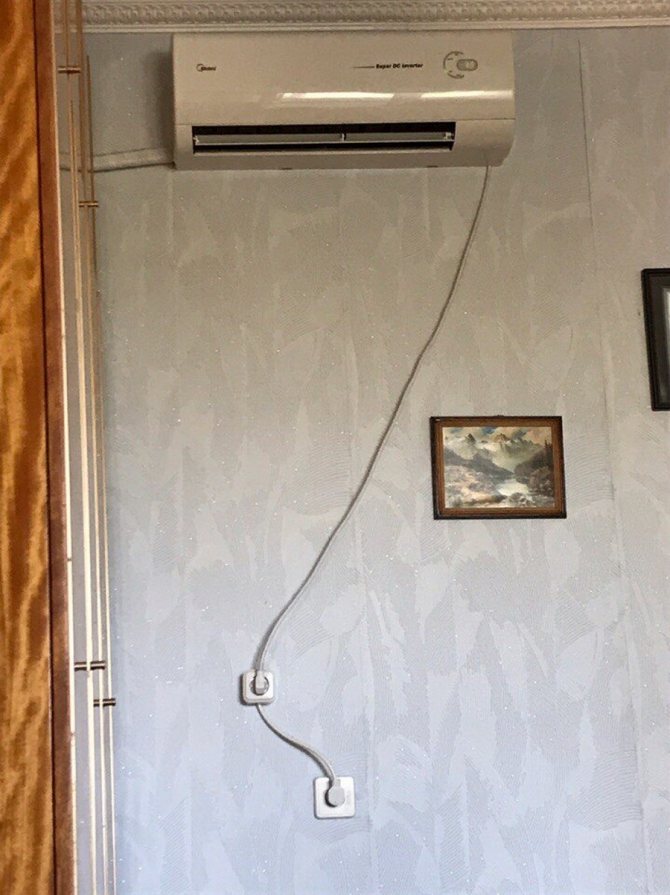

Dangling wires from a household air conditioner can ruin the entire interior of a living space, because they make the room look untidy
When designing and installing climatic equipment, it is worth “hiding” the socket between the air conditioner case and the nearest wall so that it looks as harmonious as possible.
If this is not possible, it can be installed under or to the side of the device (not on the side of an adjacent wall). It is not worth mounting the outlet above the equipment, because in this case you will have to hang the air conditioner slightly lower.
Installing the socket
Before buying an outlet, you need to know that it must meet special requirements. The parameters need to be checked carefully:
- Connection only through a circuit breaker - residual current device.
- Coincidence of the individual requirements specified in the instructions for the split system with the parameters of the electrical outlet.
- Availability of high-quality, modern grounding - this is especially true for private houses, cottages.
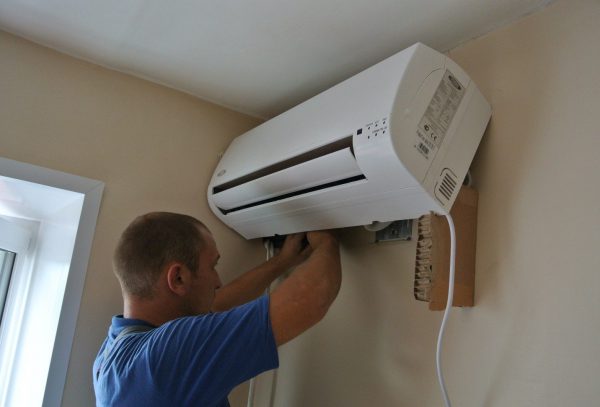

It is recommended to purchase euro sockets that are suitable for switching on high power equipment.After mounting the sockets, you should entrust the initial connection of the air conditioner to the specialists of the center - only in this way the guarantee will be preserved. If the connection is made independently, in the event of a breakdown, the manufacturer, the seller has the right to refuse repair.
General rules when choosing a place for an outlet
When choosing a place for mounting an individual outlet, you need to take into account the power of the climatic equipment, the location of other technical devices in the room, the thickness of the section of the electrical wiring and the specifics of the layout of the room.
Appliances and furniture should not become an obstacle to connecting a household air conditioner to an outlet. Also, you should not put plants and flowers in front of the outlet, because they often have to be watered, and therefore there is a risk of accidental spillage of water and getting it into the socket.
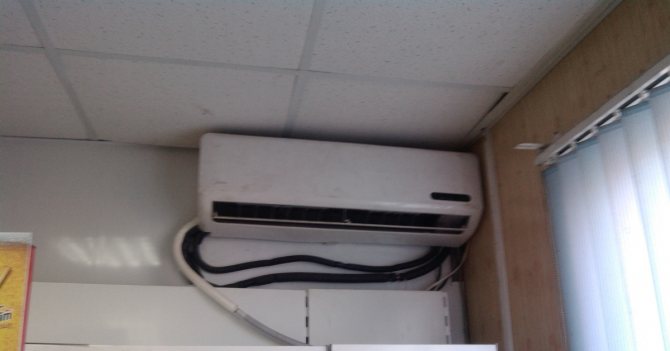

The cord from the air conditioner to the outlet should not go around paintings, wall clocks, shelves and various interior items
It is forbidden to mount the socket next to gas pipelines. Ideally, the distance between the gas pipes and the electrical outlet should be at least half a meter.
In addition to these parameters, other factors must be taken into account:
- the total load on the selected power line, taking into account all connected electrical appliances;
- the ability to change the cable routing scheme;
- the presence of an overload machine in the house, etc.
The air conditioner cord most often has a length of up to a meter, so the outlet must be installed as close to the device as possible (ideally, it should be located at the level of the device body mounting). After all, otherwise you will have to pull the extension cords across the entire room, which can negatively affect the interior.
In addition, extension cords and adapters are unnecessary connections and additional contacts, therefore, manufacturers of climatic equipment recommend avoiding such a multi-stage connection.
Because of this, the distance from the ceiling to the electrical outlet is usually less than 30 cm, since the air conditioner itself is fixed high above the ceiling. In this case, the distance between the outlet and the ceiling should not be less than 15 cm.
But there are exceptions to any rule. For example, if a very wide molding (ceiling plinth) is installed in the room, then the outlet will have to be lowered below the ceiling.
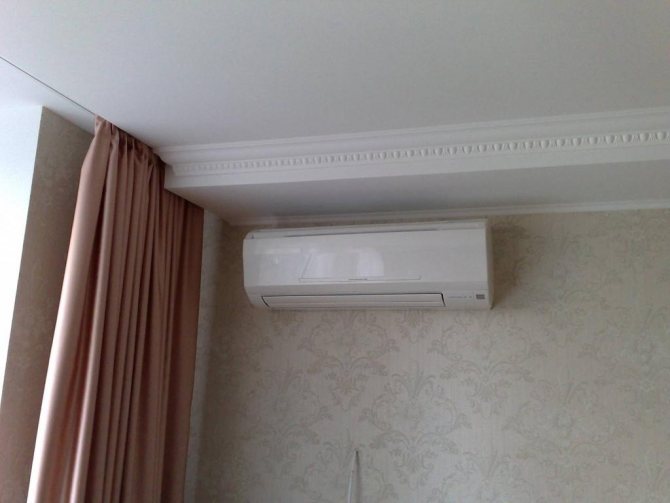

When installing sockets for air conditioning equipment, it is necessary to take into account the design features of the room in which the air conditioning equipment is installed
If the outlet cannot be installed under the ceiling, and it is mounted at the bottom of the wall, then you should not install it too low either. The ease of use of the room depends on the height at which the outlet for the air conditioner is located from the floor.
Experts advise to do it at a height of 10-15 cm, because then when washing the floor, water will not enter the connector. But in most cases, the sockets in the apartment are located much higher.
According to the European standard, they are installed at a height of 30 cm from the floor, and according to the Russian standard (it remained from Soviet times) - 90 cm.The distance between the outlet and the window slope should be at least 10 cm, and between the outlet and the nearest wall should be be at least 20 cm.
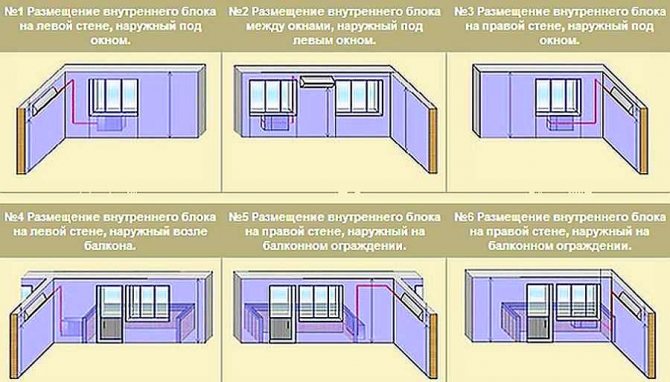

Before installing the domestic air conditioner, electrical wiring and standard outlet, measurements should be taken in the room and on the plan
All grounded metal elements (batteries, heating pipes, water pipes, etc.) must be located at a distance of at least 50 cm from the outlet of the electrical network. Also, the electrical wire is additionally protected from heating pipes with insulation.
Industrial models with high power are directly connected to the switchboard. For this, an additional cable is laid in the room. Also, the outdoor unit of split systems is connected directly to the electrical panel.The indoor unit cord can be plugged into a regular indoor outlet.
The presence of a separate line and a separate machine when connecting climatic equipment has a number of advantages:
- In the event of a breakdown of the air conditioner and a short circuit on the line, the rest of the electrical appliances will work in standard mode.
- If there is a separate line, you can install an air conditioner of any capacity without calculating the total load on the wiring.
- The presence of a separate line makes it possible to install additional differential protection and control system. This is true in the case that the outdoor unit of the air conditioner is accessible for touching.
Regardless of where the AC outlet is installed, it must be grounded or a differential relay. Grounding is an artificially created contact between an electrical device and ground, due to which the voltage of an electrical installation is reduced.
Lack of grounding can lead to a potential on the case and on all metal parts of the air conditioner at half the phase voltage due to the presence of a power filter. Manufacturers of any climatic equipment indicate the presence of mandatory grounding in the passport, so they should not be neglected.
Also, all electrical wires from the outlet must be suitable for the load. It is best to choose reliable copper three-core wires in white, blue and yellow-green (phase, zero and ground), since aluminum has a lower electrical conductivity. If the socket has aluminum wires, it is better to replace them with copper wires.
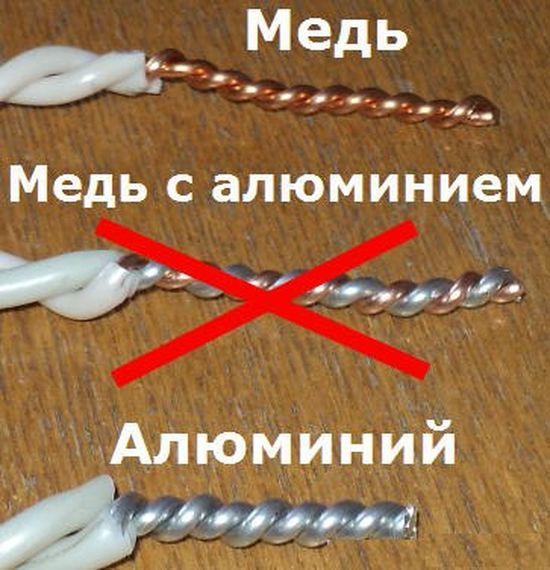

When connecting aluminum and copper wires, twists should be avoided due to the high risk of fire in the places of their connection
It is best to take wires with a cross section of about 2.5 mm2. If the cross-section of the wires is too small, they will not withstand the load.
Air conditioner fan motor selection
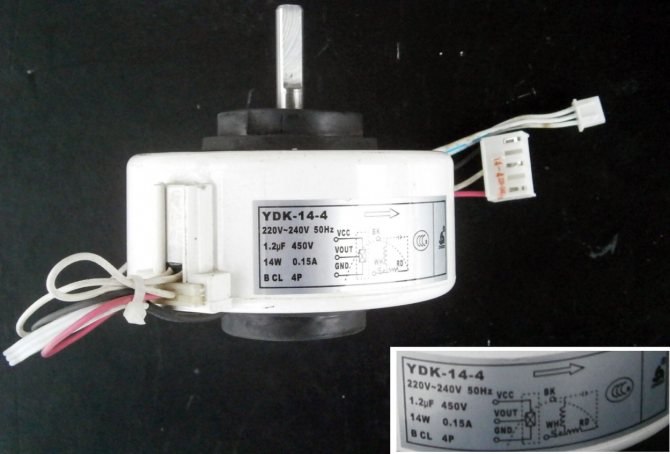

PG motor
In a split system, the engine is located in both the outdoor and indoor units. The fan motor of the outdoor unit of the air conditioner is made of metal, and the internal one is made of durable plastic.
Engine types:
- Multi-winding: different fan speeds are obtained by supplying energy to different windings.
- DC-inverter - most often used in inverter motors. By changing the amplitude of the constant voltage, the rotation speed is regulated.
- PG-motor - with the help of a regulating element (triac or thyristor), voltage is applied through the winding, which consists of two parts. Different fan speeds are achieved by varying the amplitude of the control voltage.
Armed with knowledge, the user can easily select the engine for the air conditioner and detect problems in the system in time.
Connecting the air conditioner to the network
Before connecting the split system to the mains, you should familiarize yourself with the diagrams and specifications for the unit's units and analyze the composition of the walls. Then you need to inspect the existing power supply system, measure the cross-section of the incoming cables and test the selected route with a special detector.
There are several ways to connect the air conditioner to the mains. If the wiring line for a powerful electrical appliance was not provided in advance, you will have to lay networks and install sockets after overhaul.
The most convenient way is to connect the socket in the junction box of the room. But this becomes possible only if the electrical wiring from this box to the electrical panel of an apartment or private house can withstand the maximum possible load of all connected electrical appliances.
Another method involves laying new wiring lines.In this case, you need to grind the wall, lay a new cable in a plastic corrugated pipe and connect it to the junction box. If the depth of the strobe is more than 2 cm, the cable can be hidden in the wall without a corrugated tube.
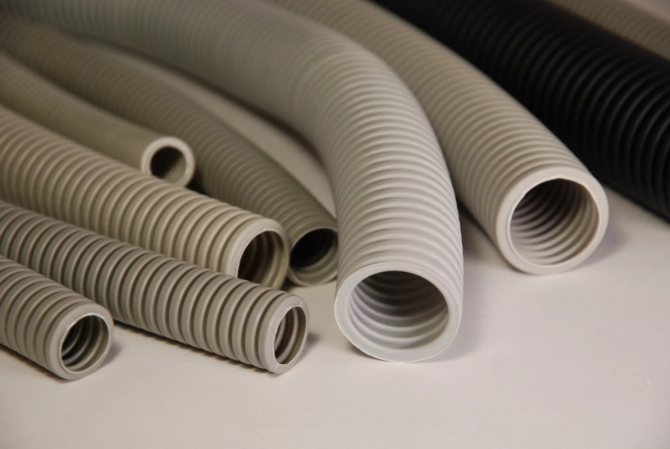

A corrugated pipe (corrugated pipe) is a pipe with a variable cross-section, in which there are thick-walled and thin-walled sections that give it rigidity and flexibility at the same time
The strobe can run horizontally or vertically, but it cannot be located diagonally. This is contrary to the basic building regulations.
On the basis of the project for the arrangement of lines, it is possible to determine in advance the places for the outlet of the electrical network, incl. and for climatic technology. If it is not possible to cut the wall, the electrical wiring can be laid in an open way.
In this case, the wires are hidden in a special plastic cable channel, which is fixed to the wall with screws. This method is the least time consuming and costly, but the plastic channel can disrupt the appearance of the room.
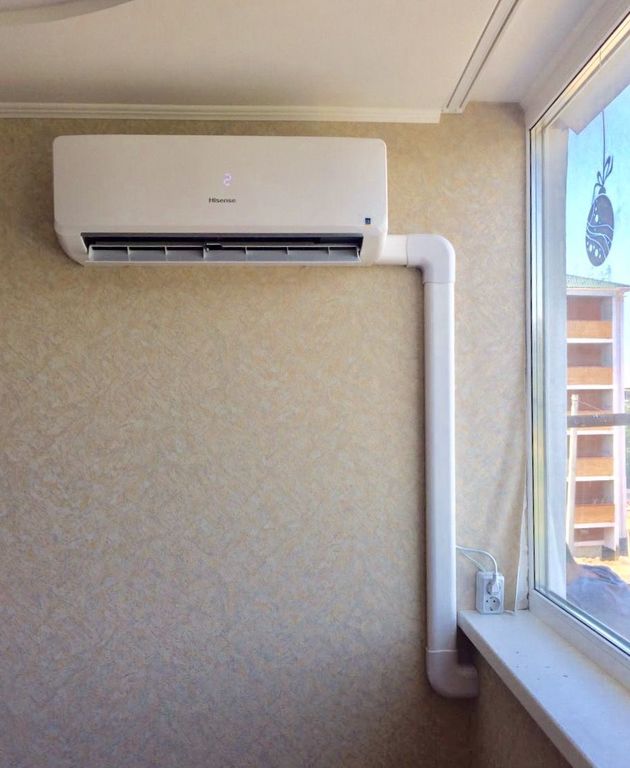

You can hide the cord from the household air conditioner to the power outlet in a plastic box of any color and shape, depending on the features of the room interior
If none of these methods work, you can daisy-chain the device to an outlet that powers a lower-wattage appliance. In this case, the loop stretches from the socket next to the air conditioner to the very point of power supply. But you need to check the capabilities of the outlet. If the network cannot handle the load, the wires will burn out.
Connecting the split system to the power supply using a plug and a previously installed socket is the easiest way. To do this, you do not need to perform electrical work, so any person can handle such a connection.
This mounting option is chosen for:
- split systems of low power (up to 4 kW);
- air conditioners built into the window;
- air conditioners that were installed in the room for a short time.
But it is better to work out the location of climatic equipment and sockets for it in advance. This will allow you to lay more reliable wires to the outlets from which the air conditioner will be powered in the future.
Signs of ventilation disease
Before talking about possible technical diseases of ventilation, it is necessary to understand that the cooling fan of the air conditioner radiator creates a forced air flow necessary for the entire air conditioning system. The service life of the unit largely depends on the speed at which the fan blades rotate.
When it is impossible to start the fan, you should find out the reason why there is no cooling. The unit may be out of order. It is located in front of or behind the radiator.
A resistor unit is often the cause of a malfunction. In case of an unusual situation, attention should be paid to the speed regulator.
Three types of breakdown are considered the most common:
- The fan does not work when the power unit is warming up.
- The fan does not turn off: it runs constantly.
- The fan starts up prematurely.
Experts recommend sounding the alarm in the first case, when the fan is not working. Since in this situation there is a high probability of overheating of the motor out of order. Most often, the power supply circuits and the t0 sensor are connected. The electric motor rarely fails. You can find out the true state of affairs in this way.
- Ring the circuit using a probe or tester.
- Connect the fan directly using the rechargeable battery. When starting the fan from the battery, it can be argued that the matter is in the wiring or in the temperature sensor.
- If everything is in order with them, the only option remains: an electric motor. In this case, you need to disconnect and short-circuit the wires connecting the t0 sensor. If the fan starts to move, therefore, the sensor itself will need to be replaced.
Service station foremen in their work mainly use special devices and computers (we are talking about checking machines with electronic control). The device will always detect a malfunction and issue an error code.
Continuous fan operation can also be associated with a coolant temperature sensor. Often the cause of breakdown is sticking contacts or jamming of the thermostat.
If turned on prematurely, the same temperature sensor can become the cause of unstable operation of the fan.
How to hide the socket of a split system?
The sockets for the air conditioner are usually visible. They do not need to be forced with furniture or appliances, but sometimes they can disrupt the overall design concept of the entire room.
This even applies to modern flat sockets, which only slightly protrude on the wall, which is to say about the usual "pot-bellied" models. In this case, designers go for small tricks and mask the sockets in the most unusual ways.
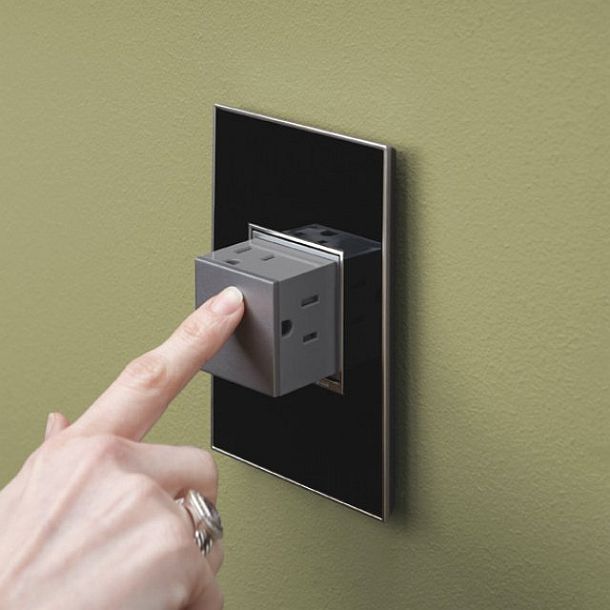

Spectacular retractable sockets are ideal for living spaces made in a modern style (hi-tech, modern, gothic, etc.)
For example, the socket is mounted in a shelf on which the climatic equipment stands, is hidden in a three-dimensional picture next to the air conditioner, or is made in the form of a block that slides out of the wall when pressed. The latter option is suitable if the air conditioner is only occasionally connected to the power supply.
Also, sockets with covers (hinged and retractable) are produced today. These covers can be additionally decorated, painted in a bright color or made as invisible as possible.
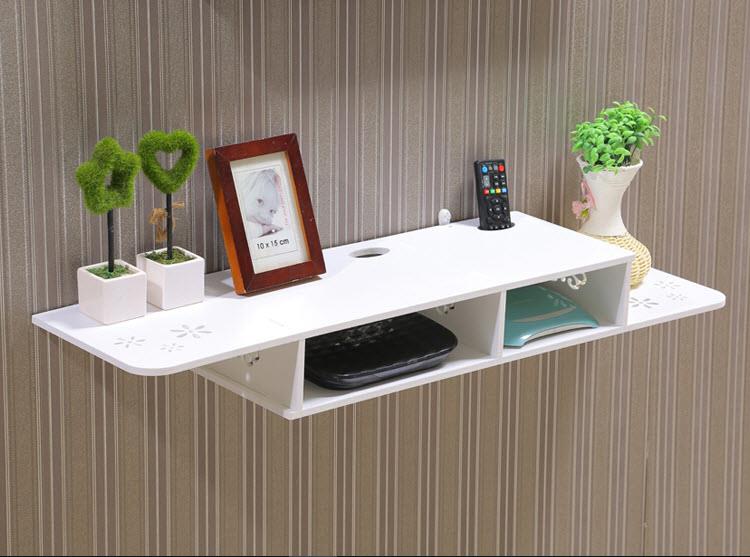

The shelf next to the air conditioner, in which the electrical outlet is hidden, can also be used for its intended purpose, i.e. you can put books or figurines on it
If there is a closet next to the air conditioner, then the socket can be hidden in it and arranged in the form of a retractable unit (top, bottom or side). It can also be closed with a false panel or cornice.
If the climatic equipment has too long a cord, then it, together with the outlet, can be masked using a non-standard volumetric drywall block made in the same interior style.
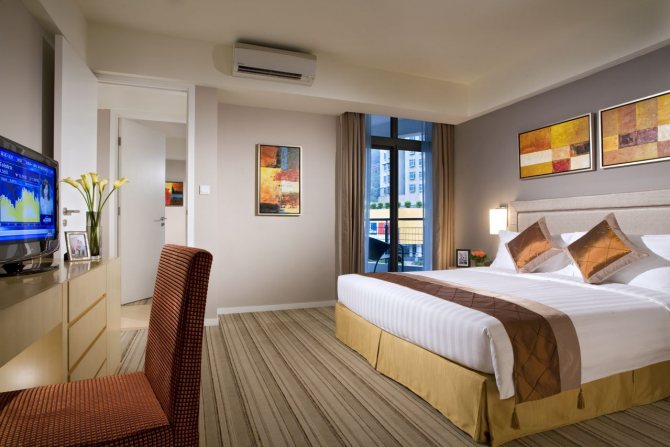

Installing an unusual painting near the air conditioner in the bedroom, hallway or living room allows you to refresh the interior of any living space
There are also other ways to mask outlets today. They can be closed in a small cabinet with sliding doors or covered with a folding mirror. If the style of the interior allows, the connector can be placed behind a small decorative door. Such a solution will look interesting in country style interiors, Provence, chalets, etc.
The rosette can be covered with artificial flowers. In a bedroom or living room, you can use a print, stained glass panel or drawing to mask the connector to make it look part of the design composition.
In the children's room, an electrical outlet can be hidden behind a retractable multi-colored panel, an interactive map or any three-dimensional models. For example, if a child is fond of Star Wars, then you can hide the connector behind a plastic model of the Death Star or Millennium Falcon.
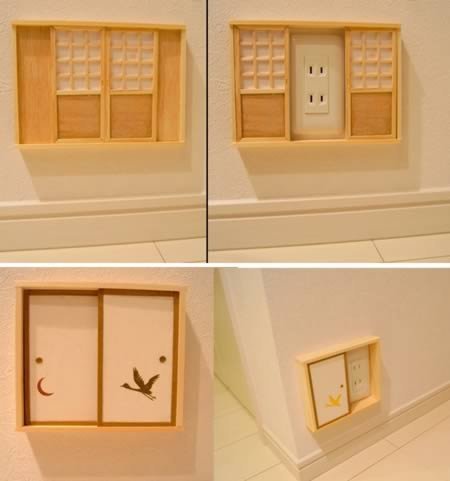

You can hide the outlet for the air conditioner in a mini-locker in the living room, in the corridor, in the bedroom, and in the children's room.
Typically, the sockets for the air conditioner are hidden in the same way as the sockets for other household appliances in the room. The choice of this or that masking method depends on the design features of the room. But today some architects propose not to hide the sockets and wiring to the air conditioner, but to make them as open as possible.
Moreover, the design concept provides for the use of wires of contrasting colors (for example, on a white wall, fix black wires almost in the central part of the wall).If the wiring of the air conditioner is open, then there will be no point in installing a hidden outlet, and this detail can be made bright.
When the air conditioner cannot be plugged into the outlet?
The climatic equipment can be connected to the household network both in an apartment and in a country house, but certain conditions must be met for this. Otherwise, there is a risk of an emergency.
So, it is forbidden to connect air conditioners to the outlet if:
- there is no good grounding;
- the electrical wiring is in poor condition (for example, there is only old-style aluminum wiring in the room, which will not be able to withstand the load from the air conditioner);
- there are no devices that equalize voltage drops (this is especially dangerous in houses with wooden floors);
- the cable has insufficient cross-section for connection, etc.
HVAC equipment requires proper electrical wiring. It is sensitive to voltage surges and can become unusable in the event of any problems on the power line.
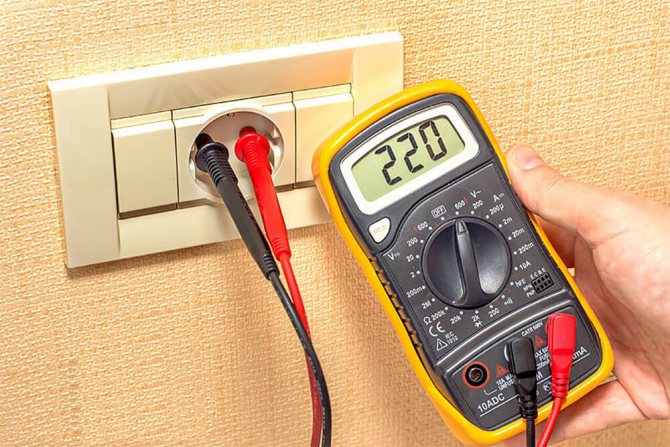

Before installing and connecting the household air conditioner to the network, you need to check the operation of the electrical outlet using a special tester
You can check the performance of the outlet at home. To do this, you just need to buy a tester and read its instructions.
Laws and technical regulations
After choosing a place for mounting the access point, there are several important details to pay attention to. These include:
- Power cable length.
- Cable section type.
- The number of cores in the cable.
The following recommendations are also relevant:
- Opt for copper wiring for the room, since it is recognized as the most reliable.
- If the apartment is equipped with aluminum wiring, it will have to be replaced.
- It is customary to use a single-phase connection to connect air conditioners, therefore it is necessary to check this characteristic before installing the electrical outlet.
As mentioned above, the height of the outlet for the air conditioner will directly depend on the size of the device. It can be installed both at the bottom and at the top of the wall.
We recommend that you familiarize yourself with: Cooker hood
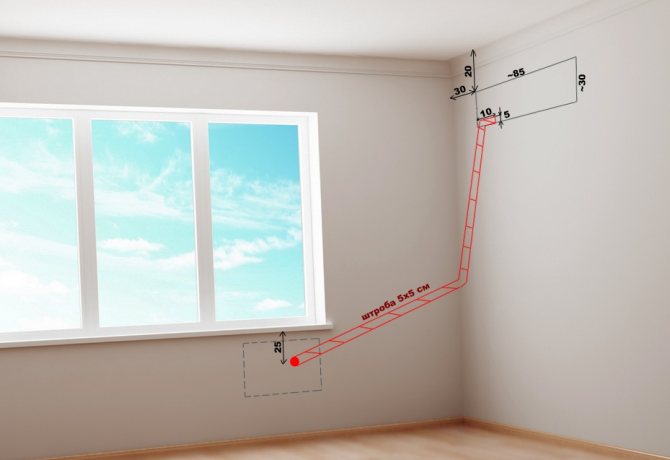

Conclusions and useful video on the topic
Since the installation of an air conditioner and sockets for it takes a lot of time and effort, then the issues of its power supply should be taken as seriously as possible. Before installation, you should use the advice of electricians and designers.
Some recommendations for installing outlets in an apartment are given in the video below:
If possible, design the location of the individual outlet and lay a separate power line to ensure the smooth operation of the climatic equipment. This can be done both at the stage of major overhaul of the premises, and during the installation of an air conditioner in an already repaired room.
Tell us about where and how you placed the electrical outlet for the air conditioner in your apartment / office / house. Share the nuances of the location that only you know. Please leave comments, ask questions, post photos in the block form below.

